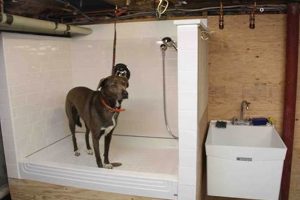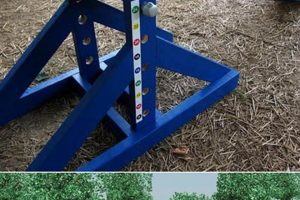A do-it-yourself (DIY) dog ramp designed for vehicular use is a structure created by pet owners to facilitate a canine’s entry and exit from automobiles. Typically constructed from materials like wood, metal, or durable plastics, these ramps provide an inclined plane that reduces the need for jumping. An example would be a wooden platform with a non-slip surface extending from the ground to the car’s cargo area, enabling a dog to walk into the vehicle.
The importance of constructing these assistive devices lies in minimizing physical strain on canines, particularly those that are aging, arthritic, or recovering from injuries. Benefits extend to preventing potential joint damage and ensuring safer travel for pets. Historically, improvised solutions were common; however, the increasing availability of materials and online tutorials has led to a surge in customized, safer, and more aesthetically pleasing designs.
The following discussion will delve into the specific considerations involved in building such a ramp, including material selection, design principles that prioritize stability and safety, and step-by-step construction guidance for several popular designs. Considerations such as portability and storage solutions will also be addressed.
Construction Guidance
The subsequent guidelines emphasize safety and durability when undertaking the creation of a canine access structure for vehicles. These suggestions are designed to optimize the ramp’s functionality and ensure the animal’s well-being.
Tip 1: Material Selection: Prioritize weather-resistant materials such as pressure-treated lumber or marine-grade plywood to mitigate degradation from exposure to the elements. This is especially crucial if the ramp will be frequently used outdoors.
Tip 2: Surface Traction: Incorporate a high-traction surface to prevent slippage. This can be achieved through the application of non-slip paint, the addition of carpet strips, or the use of textured rubber mats. Consistent surface grip is vital for confidence and safety.
Tip 3: Angle of Inclination: Design the ramp with a gentle slope. Steeper angles increase the risk of falls and can be difficult for dogs with mobility issues to navigate. Test the ramp’s angle with the intended user to ensure suitability.
Tip 4: Weight Capacity: Determine the maximum weight the ramp will need to support and construct it accordingly. Over-engineer the structure to provide a safety margin and prevent structural failure under stress.
Tip 5: Secure Attachment: Develop a secure attachment mechanism to prevent the ramp from shifting during use. This may involve hooks, straps, or non-slip feet that firmly grip the vehicle’s surface. Stability is paramount to prevent accidents.
Tip 6: Portability Considerations: If portability is required, design the ramp to be foldable or collapsible. This allows for easier storage and transport without compromising structural integrity. Ensure all folding mechanisms are robust and secure.
Tip 7: Edge Protection: Integrate side rails or edge protection to prevent the dog from accidentally stepping off the ramp. Raised edges offer added security and help guide the animal during ascent and descent.
These tips emphasize that careful planning and execution are vital for creating a safe and functional assistive device. By adhering to these guidelines, a robust and reliable structure can be achieved.
The following sections will provide specific construction plans and detailed instructions for building various types of ramps.
1. Material Durability
Material durability is a critical determinant of the longevity, safety, and overall efficacy of a do-it-yourself dog ramp for car use. The ramp is subjected to various environmental stressors, including fluctuating temperatures, moisture exposure, and the repetitive impact of a canine’s weight. Consequently, selecting materials that resist degradation under these conditions directly affects the ramp’s useful lifespan and structural integrity. The ramifications of inadequate material durability range from minor cosmetic damage to catastrophic structural failure, potentially causing injury to the animal. For example, untreated wood exposed to consistent moisture may warp or rot, compromising the ramp’s load-bearing capacity. Similarly, metal components susceptible to corrosion can weaken over time, leading to joint failure.
The practical application of this understanding necessitates a careful evaluation of material properties relative to the intended usage environment. In regions with frequent precipitation, the use of pressure-treated lumber or marine-grade plywood becomes essential. These materials possess enhanced resistance to water damage and fungal decay, prolonging the ramp’s operational life. Alternatively, aluminum, chosen for its lightweight and corrosion-resistant properties, can be implemented for the frame construction. Furthermore, selecting appropriate fasteners, such as stainless steel screws, is essential to prevent galvanic corrosion and maintain structural integrity. The choice of surface coverings also plays a role; for instance, outdoor-rated carpets or rubberized coatings can provide both traction and protection against the elements.
In conclusion, material durability is an indispensable component in the design and construction of a reliable pet access structure for automotive use. The selection of durable materials directly influences the ramp’s lifespan, safety, and resistance to environmental degradation. Overlooking this aspect can lead to premature failure, increased maintenance costs, and potential injury to the animal. Therefore, a thorough assessment of environmental factors and material properties is paramount in ensuring the enduring performance of such a structure. Furthermore, the appropriate choice of materials can present challenges, such as the initial investment cost; however, the long-term benefits in terms of safety and reduced maintenance outweigh these considerations.
2. Angle Stability
Angle stability, in the context of a do-it-yourself dog ramp for car access, denotes the ramp’s capacity to maintain a consistent and secure incline, irrespective of external forces or variations in the vehicle’s height. This stability is crucial to prevent sudden shifts, wobbling, or collapse, which could result in canine injury.
- Adjustable Supports
Adjustable supports, typically in the form of telescoping legs or hinged extensions, allow the ramp’s angle to be customized to match the varying heights of different vehicles or terrains. For instance, a ramp used with a low-riding sedan requires a shallower angle than one used with a taller SUV. Adjustable supports ensure that the ramp remains level and stable, preventing abrupt changes in incline that could startle or destabilize the dog. Without such adjustments, the ramp may rest unevenly, leading to a precarious walking surface.
- Secure Locking Mechanisms
Secure locking mechanisms are essential to prevent the accidental collapse or adjustment of the ramp during use. These mechanisms can range from spring-loaded pins to threaded knobs, depending on the design of the adjustable supports. A ramp with a poorly designed locking mechanism may inadvertently retract or fold while the dog is using it, resulting in a fall. Robust locking mechanisms guarantee that the selected angle remains fixed throughout the dog’s ascent or descent.
- Wide Base of Support
A wide base of support distributes the dog’s weight evenly across the ramp’s structure, minimizing the risk of tipping or wobbling. This is particularly important for larger or heavier breeds. A narrow base may concentrate the load, causing the ramp to become unstable, especially when positioned on uneven surfaces. Widening the base improves stability and provides a more secure platform for the animal.
- Anti-Slip Ground Contact Points
Anti-slip materials, such as rubber feet or textured pads, applied to the ramp’s ground contact points prevent the ramp from sliding or shifting on various surfaces. These materials provide friction, anchoring the ramp in place and reducing the likelihood of movement during use. Without adequate anti-slip features, the ramp may slide on slick surfaces like pavement or grass, increasing the risk of falls. Secure ground contact is vital for maintaining angle stability.
These facets collectively contribute to the overall angle stability of a canine access structure for vehicles. The presence of adjustable supports, secure locking mechanisms, a wide base, and anti-slip features enhances the ramp’s safety and reliability. The absence of these features compromises the ramp’s stability, potentially leading to accidents and injuries. A focus on these elements ensures the structure is appropriate for canine use.
3. Surface Traction
Surface traction is a fundamental design consideration for any do-it-yourself (DIY) dog ramp intended for vehicular use. It refers to the frictional resistance between the ramp’s surface and a canine’s paws, directly influencing the animal’s stability and confidence during ascent and descent. Insufficient traction can lead to slips, falls, and reluctance to use the ramp, negating its intended purpose of facilitating safe vehicle access.
- Material Selection and Grip Coefficient
The selection of surfacing materials significantly impacts the grip coefficient, a measure of frictional force. Smooth surfaces, such as polished wood or bare metal, offer minimal traction, particularly when wet. Conversely, materials like rubber, carpet, or textured composites exhibit higher grip coefficients, enhancing stability. The implementation of a rubberized coating or the application of carpet strips represents a direct effort to increase the surface’s frictional properties. Material selection should prioritize a high grip coefficient to minimize the risk of slippage.
- Textural Design and Paw Contact
The textural design of the ramp’s surface plays a pivotal role in maximizing paw contact and grip. A uniform, flat surface may not provide adequate purchase for a canine’s claws, especially under varying environmental conditions. The incorporation of grooves, ridges, or other textural elements increases the surface area in contact with the paws, providing enhanced grip. For instance, a grooved rubber mat offers improved traction compared to a smooth rubber sheet. This increased contact area translates to a more secure and confident footing.
- Environmental Factors and Surface Condition
Environmental factors, such as moisture, temperature, and debris accumulation, can significantly affect surface traction. Water, ice, or mud can reduce the grip coefficient, increasing the likelihood of slips. Furthermore, wear and tear over time can degrade the surface texture, diminishing its frictional properties. Regular cleaning and maintenance are essential to preserve the surface’s traction. Implementing drainage features or selecting materials resistant to water absorption can also mitigate the adverse effects of environmental conditions.
- Angle of Inclination and Traction Demand
The angle of inclination of the ramp directly influences the traction demand. Steeper ramps require greater frictional resistance to prevent slippage. A ramp with a shallow angle places less stress on the canine’s paws, reducing the risk of instability. The steeper the angle, the more critical is the surface’s traction. Adjusting the angle, within practical limits, to minimize the traction requirements can enhance the safety of the structure. A combination of a moderate incline and a high-traction surface is optimal.
These facets collectively underscore the critical role of surface traction in the design and functionality of a DIY dog ramp for car access. Selecting appropriate materials, implementing effective textural designs, addressing environmental factors, and considering the angle of inclination are essential for creating a safe and reliable structure. A well-designed surface traction system not only prevents accidents but also fosters confidence in the canine, encouraging regular use of the ramp and promoting safe vehicular transport. Furthermore, the expense of high-quality materials optimized for traction is offset by the reduced risk of injury.
4. Weight Capacity
Weight capacity is a paramount consideration in the design and construction of any do-it-yourself (DIY) dog ramp intended for vehicular use. It directly correlates to the ramp’s ability to safely support a canine’s weight during ascent and descent, thereby preventing structural failure and potential injury. Insufficient weight capacity renders the ramp unsafe and unusable, while an appropriately designed ramp ensures secure and reliable operation. The relationship is causal: the ramp’s structural integrity, defined by its weight capacity, directly affects its suitability for its intended purpose. Failure to adequately account for the dog’s weight results in a potentially dangerous situation. For instance, a ramp constructed from thin plywood might support a small breed but collapse under the weight of a larger dog, causing harm.
The determination of adequate weight capacity involves several practical factors. First, the maximum anticipated weight the ramp must support must be ascertained, accounting for the dog’s current weight and any potential future weight gain. Secondly, the material selection must align with this weight requirement. Materials like thicker lumber, steel, or reinforced composites offer higher weight-bearing capabilities compared to lighter alternatives. Thirdly, the structural design plays a crucial role. Reinforcements, such as additional supports or bracing, distribute the load more effectively, increasing the ramp’s overall weight capacity. A real-world example would be the use of a central support beam beneath a wooden ramp designed for a large breed dog, preventing sagging or collapse under load. Furthermore, the ramp’s joints and connections must be robust, utilizing strong fasteners and appropriate joinery techniques to withstand the applied forces.
In summary, weight capacity represents a non-negotiable safety parameter in the creation of a DIY dog ramp for car access. The potential consequences of underestimating the required weight capacity are severe, ranging from minor accidents to serious injuries. A meticulous approach to material selection, structural design, and reinforcement is essential to ensure the ramp can safely accommodate the intended user. Regular inspection for signs of wear or weakness is also crucial to maintain the ramp’s integrity over time. Ultimately, prioritizing weight capacity translates to a safer and more reliable assistive device for canine vehicular transport.
5. Portability Design
Portability design, in the context of a do-it-yourself dog ramp for car, is a critical attribute dictating the ease with which the ramp can be transported and stored. The relationship between the ramp and its portability is causal: a well-executed portability design directly enhances the ramp’s practicality, particularly for owners who require its use in various locations. The absence of thoughtful portability design limits the ramp’s utility, restricting its application to stationary environments. The importance of this component is exemplified by the contrast between a bulky, fixed ramp, which is difficult to move and store, versus a folding or telescoping design, which offers convenient transport and compact storage.
Practical applications of portability design include features like folding hinges, telescoping sections, and lightweight materials. Folding hinges allow the ramp to collapse into a smaller footprint, reducing its storage volume. Telescoping sections achieve a similar effect, enabling the ramp to retract for easier handling. The selection of lightweight materials, such as aluminum or certain plastics, reduces the overall weight, facilitating effortless carrying. For instance, a ramp designed with a bi-fold hinge and constructed from aluminum can be readily transported in the trunk of a car and deployed as needed. This mobility is particularly advantageous for owners who travel frequently with their pets or require the ramp for use at multiple locations.
In conclusion, portability design is an essential consideration in the creation of a practical and versatile dog access structure for vehicles. Challenges in achieving optimal portability often involve balancing compactness and weight with structural integrity and safety. However, a carefully considered design, incorporating features like folding mechanisms and lightweight materials, significantly enhances the ramp’s usability and convenience. This ultimately promotes more frequent and safer vehicular transport for canine companions.
6. Secure Attachment
Secure attachment is a non-negotiable safety consideration in the context of a do-it-yourself dog ramp for car use. It refers to the method by which the ramp is connected to the vehicle, ensuring that it remains firmly in place during the dog’s entry and exit. The absence of a secure attachment mechanism can lead to ramp slippage, sudden detachment, and potential injury to the animal. The stability and reliability of a ramp are directly proportional to the effectiveness of its secure attachment system.
- Vehicle Contact Points and Friction
Vehicle contact points are the surfaces on the ramp that interface with the car, typically the bumper, tailgate, or door sill. These points should be designed to maximize friction and prevent lateral movement. Examples include the use of rubberized feet, textured surfaces, or custom-molded shapes that conform to the vehicle’s contours. Insufficient friction can cause the ramp to slide during use, particularly on smooth or wet surfaces. Adequate contact and high friction are essential for a stable connection.
- Strapping and Tethering Systems
Strapping and tethering systems employ straps, ropes, or chains to physically secure the ramp to the vehicle’s frame or structural elements. These systems add an additional layer of security, preventing the ramp from dislodging even if the contact points lose grip. For instance, adjustable straps with hooks can be attached to the vehicle’s cargo tie-down points, providing a positive connection that resists movement. Tethering systems are particularly useful for ramps used with vehicles that have limited surface area for contact points.
- Locking Mechanisms and Positive Engagement
Locking mechanisms provide a direct and fixed connection between the ramp and the vehicle. This may involve the use of pins, clamps, or latches that engage with corresponding features on the car. A positive engagement system ensures that the ramp cannot be accidentally dislodged without deliberate action. For example, a spring-loaded pin that inserts into a hole on the vehicle’s bumper provides a secure and reliable connection that resists vibration and movement. Locking mechanisms enhance the ramp’s stability and prevent unintended detachment.
- Weight Distribution and Support Structures
Weight distribution and support structures refer to the ramp’s design elements that evenly distribute the dog’s weight across the vehicle contact points. This minimizes stress on any single point and prevents the ramp from tilting or buckling. For example, a ramp with multiple support legs or a wide base distributes the load more effectively than a ramp with a single point of contact. Proper weight distribution enhances the ramp’s stability and reduces the likelihood of detachment under load.
In summary, secure attachment is a critical component of a safe and effective do-it-yourself dog ramp for car use. The combination of high-friction contact points, robust strapping systems, positive locking mechanisms, and effective weight distribution ensures that the ramp remains firmly connected to the vehicle during operation, minimizing the risk of accidents and promoting safe vehicular access for canine companions. The design and implementation of these elements require careful consideration and attention to detail to ensure the ramp’s long-term reliability and safety.
7. Edge Protection
Edge protection, as a design element of a do-it-yourself (DIY) dog ramp intended for automotive use, refers to physical barriers along the sides of the ramp surface. The purpose is to prevent a canine from inadvertently stepping or falling off the edge during ascent or descent. A lack of edge protection increases the risk of injury, particularly for dogs with impaired vision, mobility issues, or those unfamiliar with the ramp. The inclusion of edge protection directly contributes to the overall safety and usability of the ramp. A causal relationship exists: the absence of edge protection directly increases the probability of accidental falls, while its presence mitigates this risk. A ramp without such protection might be usable by a perfectly sighted, agile dog, but becomes a hazard for others.
Practical implementation of edge protection can involve various methods. Raised side rails constructed from wood, metal, or durable plastic are common examples. The height of the rails should be sufficient to provide a tactile or visual cue to the dog, guiding them along the ramp’s centerline. For smaller breeds, lower rails may suffice, while larger dogs necessitate taller barriers. A non-slip surface on the side rails further enhances their effectiveness. Alternative approaches include the use of flexible materials, such as reinforced rubber or fabric, to create a softer, less rigid edge. The selection of materials should consider both durability and safety, avoiding sharp edges or protrusions that could cause harm. For instance, a smooth, rounded wooden rail is preferable to a sharp metal edge.
In summary, edge protection is an essential safety feature in the design of a DIY dog ramp for vehicular access. Its presence reduces the likelihood of falls, increasing the ramp’s suitability for a broader range of canines, including those with physical limitations. While the addition of edge protection may slightly increase the ramp’s complexity and material costs, the safety benefits significantly outweigh these considerations. Furthermore, the presence of edge protection can reduce owner anxiety, resulting in a more positive experience for both the dog and its owner.
Frequently Asked Questions
The following section addresses common inquiries and misconceptions regarding the construction and utilization of canine access structures for vehicles, providing factual and objective information.
Question 1: What are the primary safety considerations when constructing a canine access ramp for vehicular use?
Safety considerations include ensuring adequate weight capacity, implementing a non-slip surface, providing secure attachment mechanisms to the vehicle, and incorporating edge protection to prevent falls. A stable angle of inclination is also crucial to minimize strain on the animal.
Question 2: What materials are suitable for building a durable canine ramp intended for vehicular use?
Suitable materials include pressure-treated lumber, marine-grade plywood, aluminum, and steel. Material selection should be based on factors such as weight capacity requirements, exposure to environmental elements, and desired longevity.
Question 3: How does one determine the appropriate angle of inclination for a canine access structure?
The appropriate angle of inclination depends on the height of the vehicle and the dog’s physical capabilities. A shallower angle is generally preferred, particularly for elderly or arthritic dogs. Testing with the dog is recommended to ensure ease of use.
Question 4: What are the recommended methods for securing a canine access ramp to a vehicle?
Recommended methods include the use of straps, hooks, or non-slip feet that firmly grip the vehicle’s surface. The attachment mechanism should prevent the ramp from shifting or detaching during use.
Question 5: Is it necessary to incorporate side rails or edge protection on a canine ramp designed for vehicular access?
Yes, side rails or edge protection are highly recommended to prevent the dog from accidentally stepping off the ramp during ascent or descent, particularly for those with impaired vision or mobility issues.
Question 6: How does one ensure that a do-it-yourself canine ramp is portable and easy to store?
Portability can be achieved through the use of lightweight materials, foldable designs, or telescoping sections. Compact storage is facilitated by designing the ramp to minimize its footprint when not in use.
In summary, constructing a safe and effective canine access structure for vehicles requires careful consideration of design principles, material selection, and safety features. Adherence to these guidelines ensures the well-being of the animal and the longevity of the ramp.
The following section will explore specific construction plans for various types of canine ramps, providing detailed instructions for implementation.
Conclusion
The preceding analysis has comprehensively addressed essential factors in the creation of a diy dog ramp for car. Aspects such as material durability, angle stability, surface traction, weight capacity, portability design, secure attachment, and edge protection are individually vital and collectively determine the effectiveness and safety of the assistive device. These considerations highlight the complexity involved in constructing a reliable and user-friendly ramp.
Proper implementation of these guidelines can significantly improve canine vehicular accessibility. Diligence in planning and execution remains paramount. It encourages pet owners to meticulously assess their individual needs and proceed with thoughtful construction, prioritizing safety to promote the well-being of their canine companions. Prioritize quality over convenience.







